Preoperative and Postoperative Care for Osteoarthritis Patients
VerifiedAdded on 2023/06/04
|9
|1948
|82
Report
AI Summary
This report provides a comprehensive overview of osteoarthritis, focusing on both preoperative and postoperative care for patients. It begins by defining osteoarthritis and its symptoms, followed by an exploration of conservative treatment methods such as weight loss, activity adjustments, physiotherapy, and anti-inflammatory medications. The report then delves into total hip replacement surgery, detailing the procedure, preoperative preparations including medical examinations, weight management, and medication guidelines, as well as the importance of exercise. Postoperative care is extensively covered, including pain management, physiotherapy, and hospital stay duration, along with potential risks like blood clots, infection, breakage, dislocation, and leg length changes. The report concludes by emphasizing the significance of both preoperative and postoperative procedures for successful outcomes and patient recovery, referencing relevant studies and research.
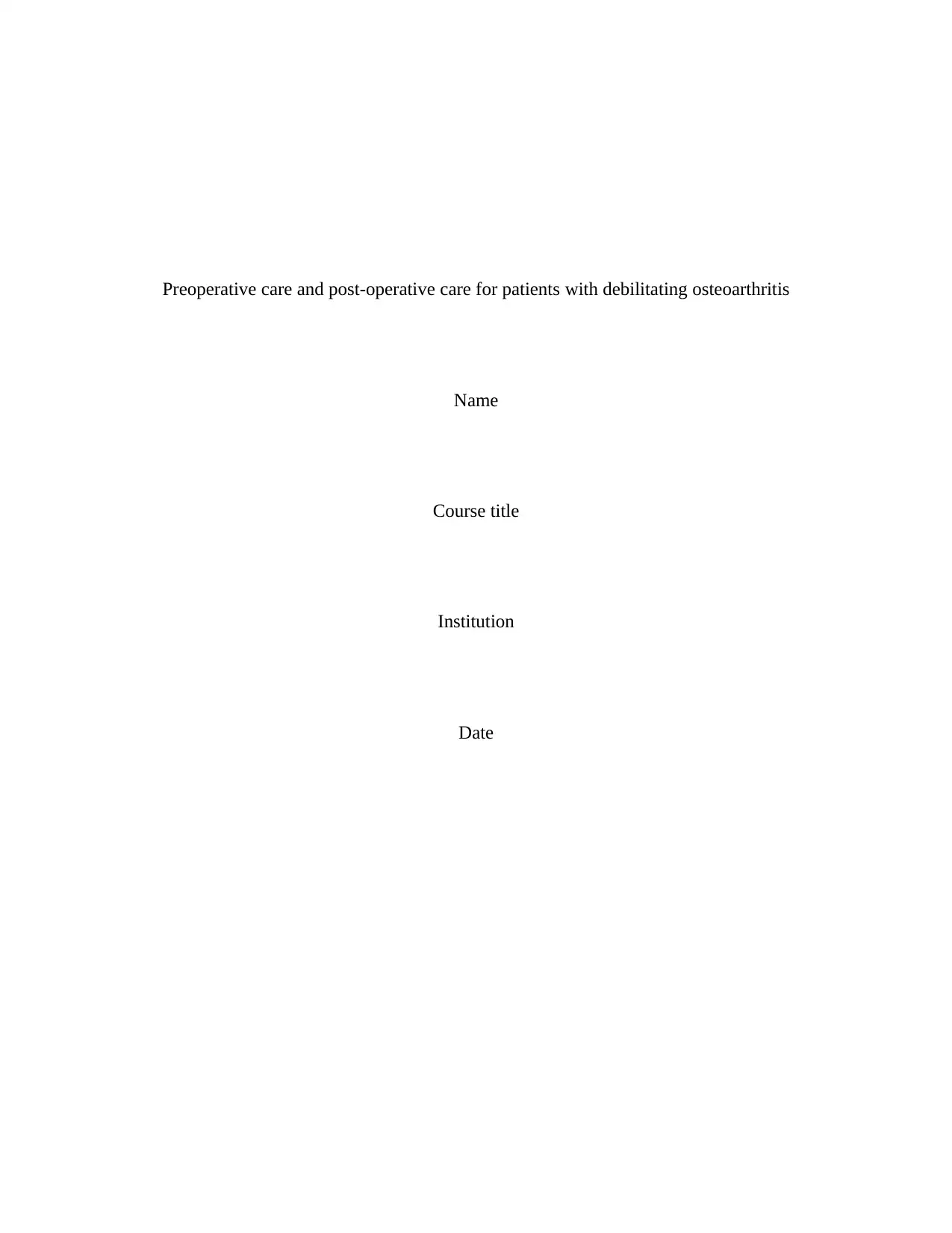
Preoperative care and post-operative care for patients with debilitating osteoarthritis
Name
Course title
Institution
Date
Name
Course title
Institution
Date
Paraphrase This Document
Need a fresh take? Get an instant paraphrase of this document with our AI Paraphraser
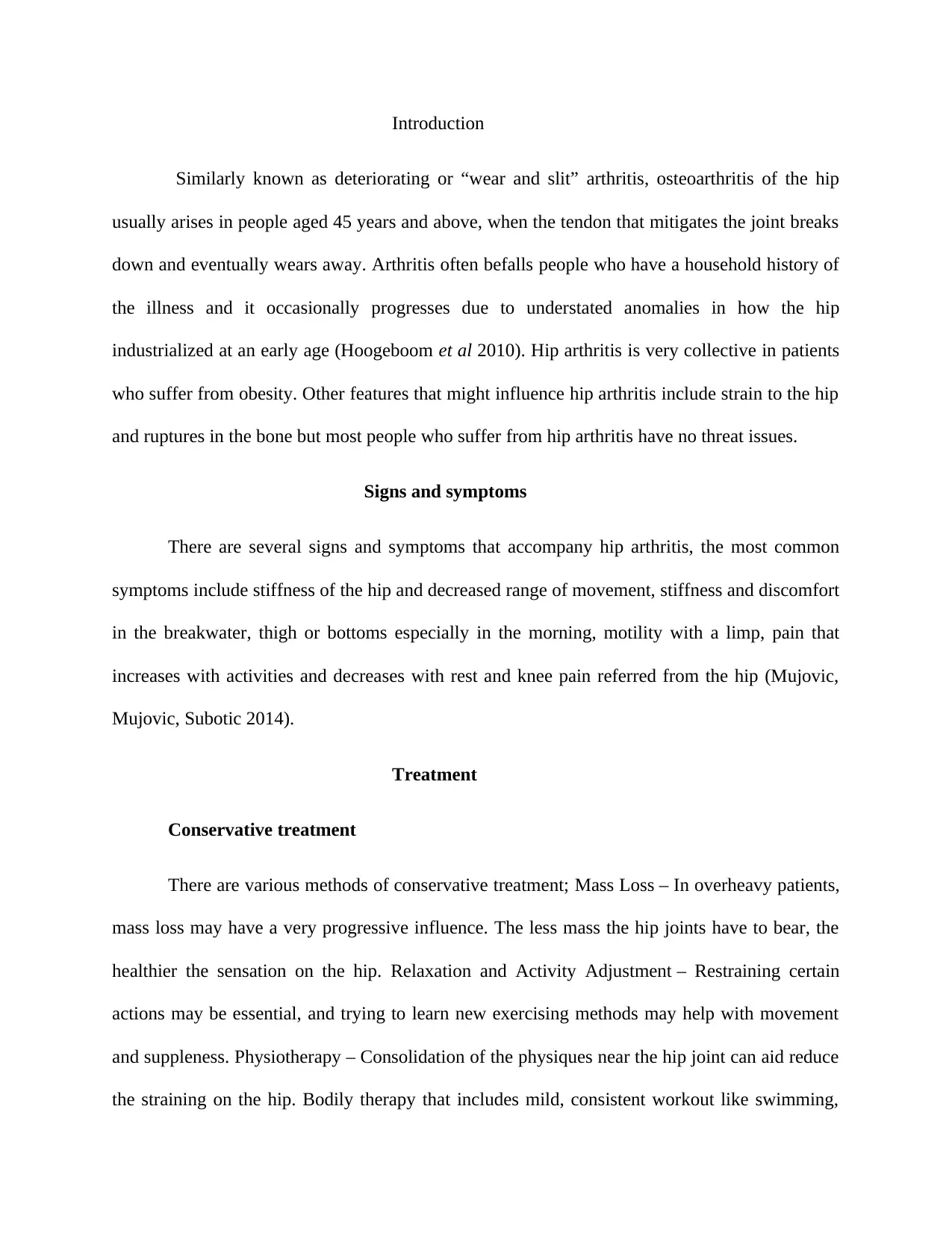
Introduction
Similarly known as deteriorating or “wear and slit” arthritis, osteoarthritis of the hip
usually arises in people aged 45 years and above, when the tendon that mitigates the joint breaks
down and eventually wears away. Arthritis often befalls people who have a household history of
the illness and it occasionally progresses due to understated anomalies in how the hip
industrialized at an early age (Hoogeboom et al 2010). Hip arthritis is very collective in patients
who suffer from obesity. Other features that might influence hip arthritis include strain to the hip
and ruptures in the bone but most people who suffer from hip arthritis have no threat issues.
Signs and symptoms
There are several signs and symptoms that accompany hip arthritis, the most common
symptoms include stiffness of the hip and decreased range of movement, stiffness and discomfort
in the breakwater, thigh or bottoms especially in the morning, motility with a limp, pain that
increases with activities and decreases with rest and knee pain referred from the hip (Mujovic,
Mujovic, Subotic 2014).
Treatment
Conservative treatment
There are various methods of conservative treatment; Mass Loss – In overheavy patients,
mass loss may have a very progressive influence. The less mass the hip joints have to bear, the
healthier the sensation on the hip. Relaxation and Activity Adjustment – Restraining certain
actions may be essential, and trying to learn new exercising methods may help with movement
and suppleness. Physiotherapy – Consolidation of the physiques near the hip joint can aid reduce
the straining on the hip. Bodily therapy that includes mild, consistent workout like swimming,
Similarly known as deteriorating or “wear and slit” arthritis, osteoarthritis of the hip
usually arises in people aged 45 years and above, when the tendon that mitigates the joint breaks
down and eventually wears away. Arthritis often befalls people who have a household history of
the illness and it occasionally progresses due to understated anomalies in how the hip
industrialized at an early age (Hoogeboom et al 2010). Hip arthritis is very collective in patients
who suffer from obesity. Other features that might influence hip arthritis include strain to the hip
and ruptures in the bone but most people who suffer from hip arthritis have no threat issues.
Signs and symptoms
There are several signs and symptoms that accompany hip arthritis, the most common
symptoms include stiffness of the hip and decreased range of movement, stiffness and discomfort
in the breakwater, thigh or bottoms especially in the morning, motility with a limp, pain that
increases with activities and decreases with rest and knee pain referred from the hip (Mujovic,
Mujovic, Subotic 2014).
Treatment
Conservative treatment
There are various methods of conservative treatment; Mass Loss – In overheavy patients,
mass loss may have a very progressive influence. The less mass the hip joints have to bear, the
healthier the sensation on the hip. Relaxation and Activity Adjustment – Restraining certain
actions may be essential, and trying to learn new exercising methods may help with movement
and suppleness. Physiotherapy – Consolidation of the physiques near the hip joint can aid reduce
the straining on the hip. Bodily therapy that includes mild, consistent workout like swimming,

water workouts or biking may be great help (Murphy, Lyden, Smith, Dong, Koliba 2010). Anti-
Inflammatory Pills – Prescription or nonprescription anti-inflammatory pain medications
(NSAIDs) are frequently used to relieve pain and treat inflammation.
Total hip replacement surgery
The total hip replacement surgical procedure is a process in which a surgeon surgically
eliminates the painful hip joint suffering from arthritis and substitutes it with a synthetic joint
usually created from metallic and malleable components. It’s commonly carried out when all the
other methods of treatment have unable to provide passable pain relief. Total hip replacement
may be executed conventionally or by use of what is considered a less -invasive procedure. The
main variance between the two processes is the mass of the incision (Escalante 2011).
Throughout regular hip replacement surgery, you are treat with all-purpose anesthesia to ease
your physiques and put you into a momentary deep slumber. This will stop you from feeling any
discomfort throughout the surgical procedure or have any consciousness of the process. A
vertebral anesthetic might be given to aid in preventing pain as a substitute.
Preoperative care
Before complete hip replacement operation, patients go through a complete somatic
examination, a dental examination, and several other tests such as chest x-ray blood tests,
urinalysis and EKG. Patients who are overweight may be advised to lose weight to reduce the
risk seven days before the operation the patient is advised not to take any NSAIDS (Nonsteroid
anti-inflammatory drugs) such as ibuprofen and aspirin for complications during and after
surgery. The patients are encouraged to begin practicing preceding the medical procedure. In
light of the fact that everybody reacts to practice in an unexpected way, you should be the judge
Inflammatory Pills – Prescription or nonprescription anti-inflammatory pain medications
(NSAIDs) are frequently used to relieve pain and treat inflammation.
Total hip replacement surgery
The total hip replacement surgical procedure is a process in which a surgeon surgically
eliminates the painful hip joint suffering from arthritis and substitutes it with a synthetic joint
usually created from metallic and malleable components. It’s commonly carried out when all the
other methods of treatment have unable to provide passable pain relief. Total hip replacement
may be executed conventionally or by use of what is considered a less -invasive procedure. The
main variance between the two processes is the mass of the incision (Escalante 2011).
Throughout regular hip replacement surgery, you are treat with all-purpose anesthesia to ease
your physiques and put you into a momentary deep slumber. This will stop you from feeling any
discomfort throughout the surgical procedure or have any consciousness of the process. A
vertebral anesthetic might be given to aid in preventing pain as a substitute.
Preoperative care
Before complete hip replacement operation, patients go through a complete somatic
examination, a dental examination, and several other tests such as chest x-ray blood tests,
urinalysis and EKG. Patients who are overweight may be advised to lose weight to reduce the
risk seven days before the operation the patient is advised not to take any NSAIDS (Nonsteroid
anti-inflammatory drugs) such as ibuprofen and aspirin for complications during and after
surgery. The patients are encouraged to begin practicing preceding the medical procedure. In
light of the fact that everybody reacts to practice in an unexpected way, you should be the judge
⊘ This is a preview!⊘
Do you want full access?
Subscribe today to unlock all pages.

Trusted by 1+ million students worldwide
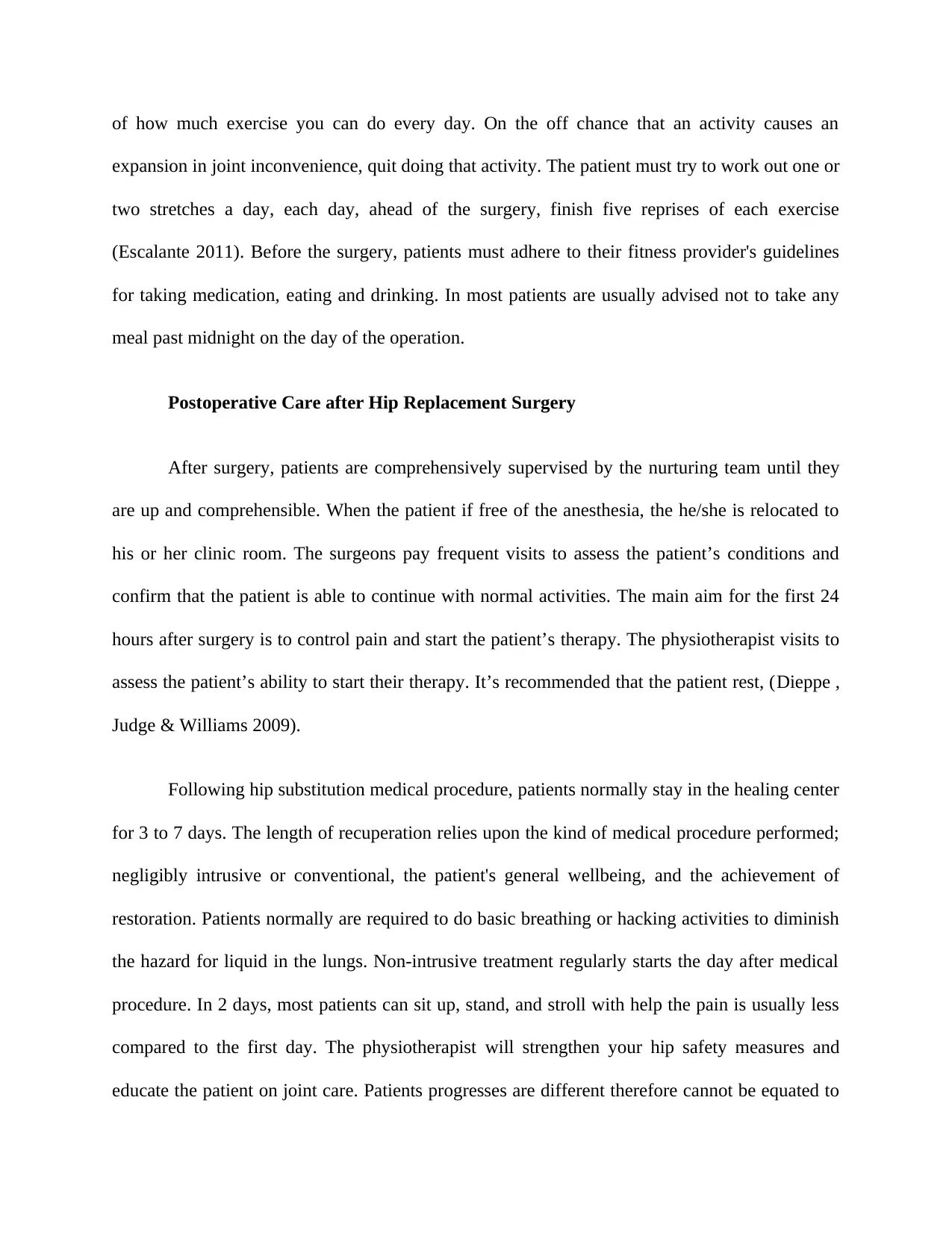
of how much exercise you can do every day. On the off chance that an activity causes an
expansion in joint inconvenience, quit doing that activity. The patient must try to work out one or
two stretches a day, each day, ahead of the surgery, finish five reprises of each exercise
(Escalante 2011). Before the surgery, patients must adhere to their fitness provider's guidelines
for taking medication, eating and drinking. In most patients are usually advised not to take any
meal past midnight on the day of the operation.
Postoperative Care after Hip Replacement Surgery
After surgery, patients are comprehensively supervised by the nurturing team until they
are up and comprehensible. When the patient if free of the anesthesia, the he/she is relocated to
his or her clinic room. The surgeons pay frequent visits to assess the patient’s conditions and
confirm that the patient is able to continue with normal activities. The main aim for the first 24
hours after surgery is to control pain and start the patient’s therapy. The physiotherapist visits to
assess the patient’s ability to start their therapy. It’s recommended that the patient rest, (Dieppe ,
Judge & Williams 2009).
Following hip substitution medical procedure, patients normally stay in the healing center
for 3 to 7 days. The length of recuperation relies upon the kind of medical procedure performed;
negligibly intrusive or conventional, the patient's general wellbeing, and the achievement of
restoration. Patients normally are required to do basic breathing or hacking activities to diminish
the hazard for liquid in the lungs. Non-intrusive treatment regularly starts the day after medical
procedure. In 2 days, most patients can sit up, stand, and stroll with help the pain is usually less
compared to the first day. The physiotherapist will strengthen your hip safety measures and
educate the patient on joint care. Patients progresses are different therefore cannot be equated to
expansion in joint inconvenience, quit doing that activity. The patient must try to work out one or
two stretches a day, each day, ahead of the surgery, finish five reprises of each exercise
(Escalante 2011). Before the surgery, patients must adhere to their fitness provider's guidelines
for taking medication, eating and drinking. In most patients are usually advised not to take any
meal past midnight on the day of the operation.
Postoperative Care after Hip Replacement Surgery
After surgery, patients are comprehensively supervised by the nurturing team until they
are up and comprehensible. When the patient if free of the anesthesia, the he/she is relocated to
his or her clinic room. The surgeons pay frequent visits to assess the patient’s conditions and
confirm that the patient is able to continue with normal activities. The main aim for the first 24
hours after surgery is to control pain and start the patient’s therapy. The physiotherapist visits to
assess the patient’s ability to start their therapy. It’s recommended that the patient rest, (Dieppe ,
Judge & Williams 2009).
Following hip substitution medical procedure, patients normally stay in the healing center
for 3 to 7 days. The length of recuperation relies upon the kind of medical procedure performed;
negligibly intrusive or conventional, the patient's general wellbeing, and the achievement of
restoration. Patients normally are required to do basic breathing or hacking activities to diminish
the hazard for liquid in the lungs. Non-intrusive treatment regularly starts the day after medical
procedure. In 2 days, most patients can sit up, stand, and stroll with help the pain is usually less
compared to the first day. The physiotherapist will strengthen your hip safety measures and
educate the patient on joint care. Patients progresses are different therefore cannot be equated to
Paraphrase This Document
Need a fresh take? Get an instant paraphrase of this document with our AI Paraphraser
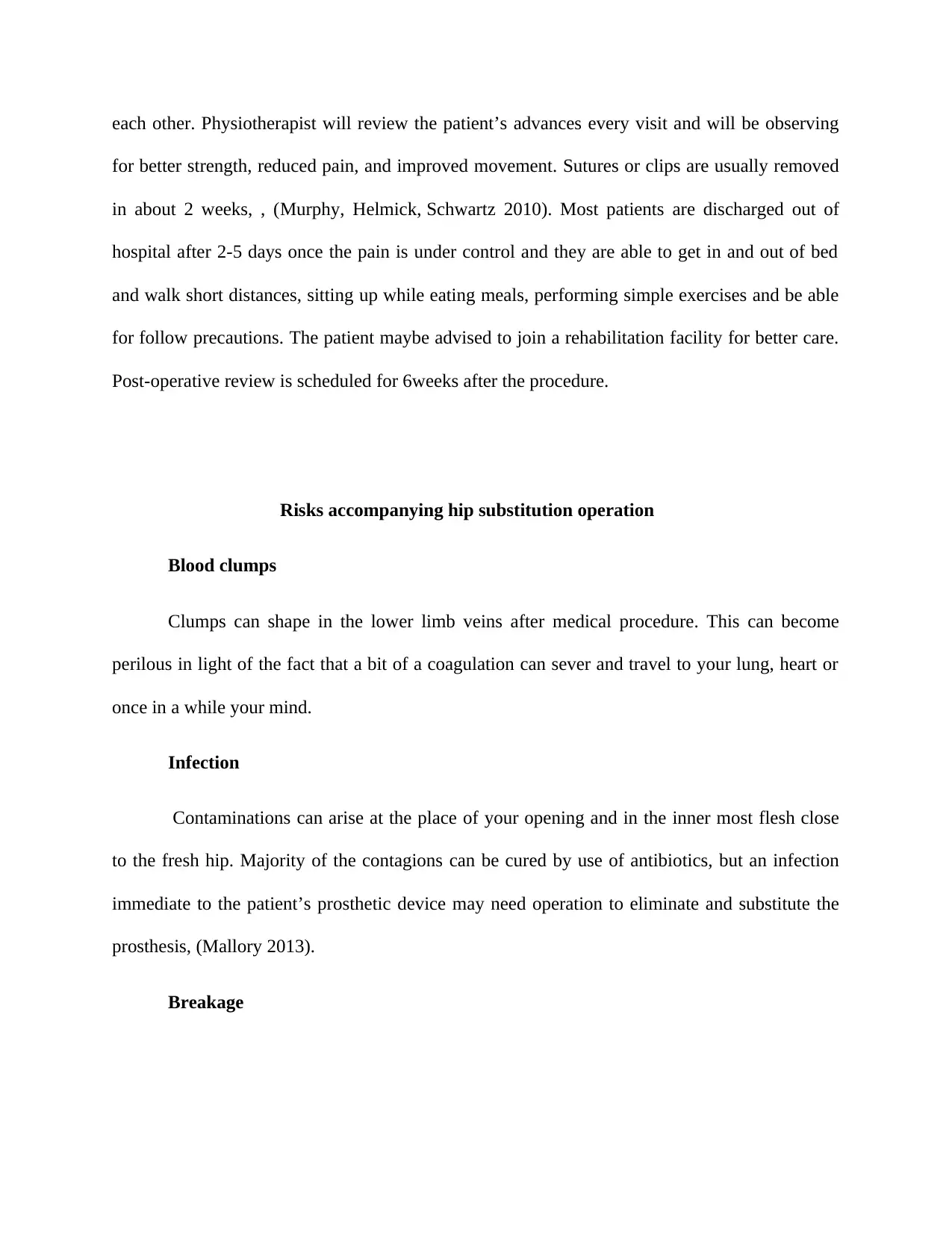
each other. Physiotherapist will review the patient’s advances every visit and will be observing
for better strength, reduced pain, and improved movement. Sutures or clips are usually removed
in about 2 weeks, , (Murphy, Helmick, Schwartz 2010). Most patients are discharged out of
hospital after 2-5 days once the pain is under control and they are able to get in and out of bed
and walk short distances, sitting up while eating meals, performing simple exercises and be able
for follow precautions. The patient maybe advised to join a rehabilitation facility for better care.
Post-operative review is scheduled for 6weeks after the procedure.
Risks accompanying hip substitution operation
Blood clumps
Clumps can shape in the lower limb veins after medical procedure. This can become
perilous in light of the fact that a bit of a coagulation can sever and travel to your lung, heart or
once in a while your mind.
Infection
Contaminations can arise at the place of your opening and in the inner most flesh close
to the fresh hip. Majority of the contagions can be cured by use of antibiotics, but an infection
immediate to the patient’s prosthetic device may need operation to eliminate and substitute the
prosthesis, (Mallory 2013).
Breakage
for better strength, reduced pain, and improved movement. Sutures or clips are usually removed
in about 2 weeks, , (Murphy, Helmick, Schwartz 2010). Most patients are discharged out of
hospital after 2-5 days once the pain is under control and they are able to get in and out of bed
and walk short distances, sitting up while eating meals, performing simple exercises and be able
for follow precautions. The patient maybe advised to join a rehabilitation facility for better care.
Post-operative review is scheduled for 6weeks after the procedure.
Risks accompanying hip substitution operation
Blood clumps
Clumps can shape in the lower limb veins after medical procedure. This can become
perilous in light of the fact that a bit of a coagulation can sever and travel to your lung, heart or
once in a while your mind.
Infection
Contaminations can arise at the place of your opening and in the inner most flesh close
to the fresh hip. Majority of the contagions can be cured by use of antibiotics, but an infection
immediate to the patient’s prosthetic device may need operation to eliminate and substitute the
prosthesis, (Mallory 2013).
Breakage
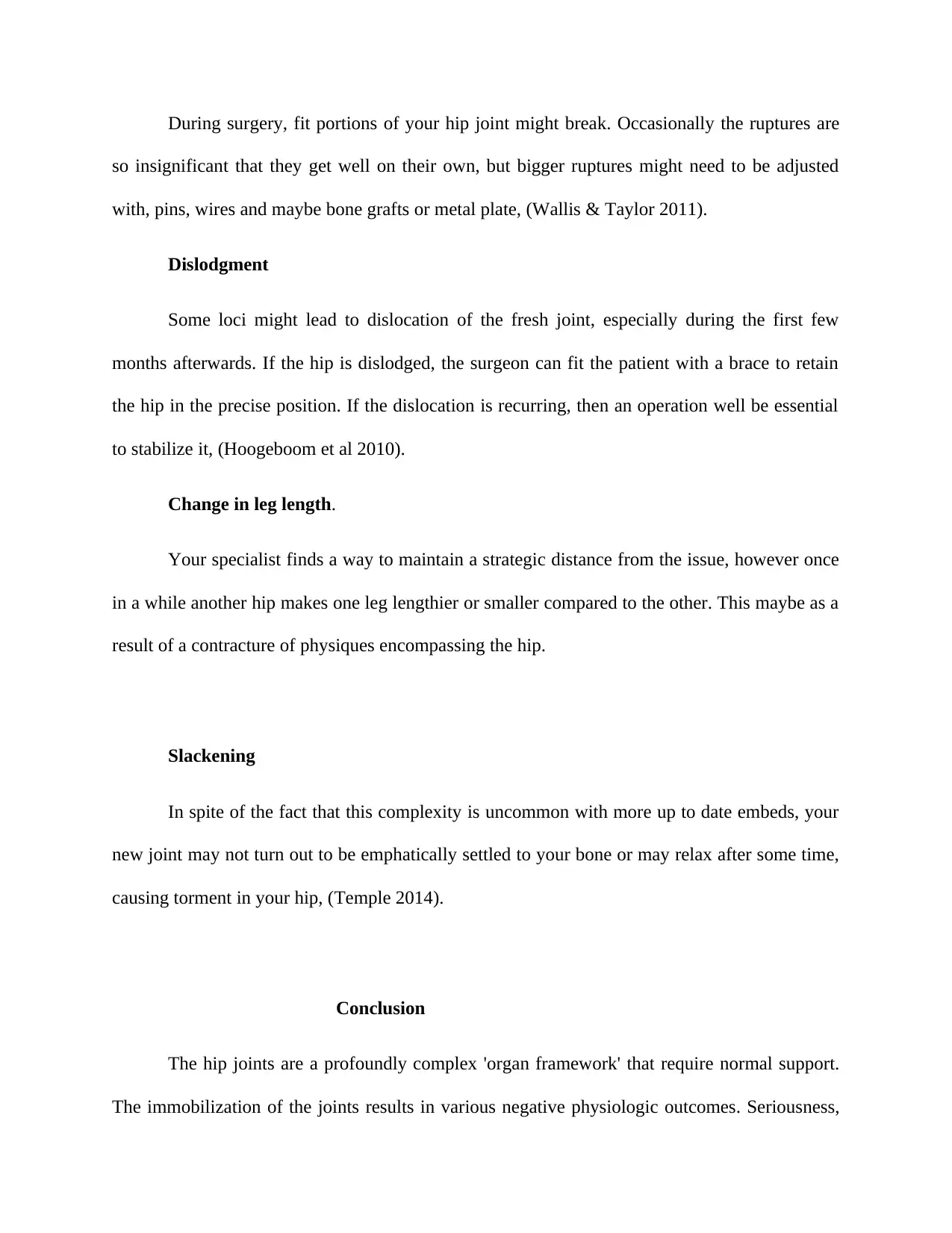
During surgery, fit portions of your hip joint might break. Occasionally the ruptures are
so insignificant that they get well on their own, but bigger ruptures might need to be adjusted
with, pins, wires and maybe bone grafts or metal plate, (Wallis & Taylor 2011).
Dislodgment
Some loci might lead to dislocation of the fresh joint, especially during the first few
months afterwards. If the hip is dislodged, the surgeon can fit the patient with a brace to retain
the hip in the precise position. If the dislocation is recurring, then an operation well be essential
to stabilize it, (Hoogeboom et al 2010).
Change in leg length.
Your specialist finds a way to maintain a strategic distance from the issue, however once
in a while another hip makes one leg lengthier or smaller compared to the other. This maybe as a
result of a contracture of physiques encompassing the hip.
Slackening
In spite of the fact that this complexity is uncommon with more up to date embeds, your
new joint may not turn out to be emphatically settled to your bone or may relax after some time,
causing torment in your hip, (Temple 2014).
Conclusion
The hip joints are a profoundly complex 'organ framework' that require normal support.
The immobilization of the joints results in various negative physiologic outcomes. Seriousness,
so insignificant that they get well on their own, but bigger ruptures might need to be adjusted
with, pins, wires and maybe bone grafts or metal plate, (Wallis & Taylor 2011).
Dislodgment
Some loci might lead to dislocation of the fresh joint, especially during the first few
months afterwards. If the hip is dislodged, the surgeon can fit the patient with a brace to retain
the hip in the precise position. If the dislocation is recurring, then an operation well be essential
to stabilize it, (Hoogeboom et al 2010).
Change in leg length.
Your specialist finds a way to maintain a strategic distance from the issue, however once
in a while another hip makes one leg lengthier or smaller compared to the other. This maybe as a
result of a contracture of physiques encompassing the hip.
Slackening
In spite of the fact that this complexity is uncommon with more up to date embeds, your
new joint may not turn out to be emphatically settled to your bone or may relax after some time,
causing torment in your hip, (Temple 2014).
Conclusion
The hip joints are a profoundly complex 'organ framework' that require normal support.
The immobilization of the joints results in various negative physiologic outcomes. Seriousness,
⊘ This is a preview!⊘
Do you want full access?
Subscribe today to unlock all pages.

Trusted by 1+ million students worldwide

portability, agony, firmness and radiographic movement might be somewhat interceded by the
level of constant aggravation in OA patients. Total hip replacement is a recommended method of
treatment for severe osteoarthritis in case of failure of conservative treatment however it may be
accompanied by complications such as blood clumps, dislodging of the hip, slackening breakage
and change in length of one limb. Pre-operative and post-operative care procedures are essential
for a successful execution of total hip replacement and the healing process of the patient.
level of constant aggravation in OA patients. Total hip replacement is a recommended method of
treatment for severe osteoarthritis in case of failure of conservative treatment however it may be
accompanied by complications such as blood clumps, dislodging of the hip, slackening breakage
and change in length of one limb. Pre-operative and post-operative care procedures are essential
for a successful execution of total hip replacement and the healing process of the patient.
Paraphrase This Document
Need a fresh take? Get an instant paraphrase of this document with our AI Paraphraser

References
Hoogeboom, T. J., Dronkers, J. J., van den, Ende, C. H., Oosting, E., & Van Meeteren, N. L.
(2010). Preoperative therapeutic exercise in frail elderly scheduled for total hip
replacement: a randomized pilot trial. Clinical rehabilitation, 24(10), 901-910.
Temple, J. (2014). Total hip replacement. Nursing Standard (through 2013), 19(3), 44.
Wallis, J. A., & Taylor, N. F. (2011). Pre-operative interventions (non-surgical and non-
pharmacological) for patients with hip or knee osteoarthritis awaiting joint replacement
surgery–a systematic review and meta-analysis. Osteoarthritis and Cartilage, 19(12),
1381-1395.
Mallory, T. H. (2013). U.S. Patent No. 6,503,281. Washington, DC: U.S. Patent and Trademark
Office.
Gill, S. D., & McBurney, H. (2013). Does exercise reduce pain and improve physical function
before hip or knee replacement surgery? A systematic review and meta-analysis of
randomized controlled trials. Archives of physical medicine and rehabilitation, 94(1),
164-176.
Murphy LB, Helmick CG, Schwartz TA.(2010). One in four people may develop symptomatic
hip osteoarthritis in his or her lifetime. Osteoarthritis Cartilage;
Escalante Y., (2011) Effects of exercise on functional aerobic capacity in lower limb
osteoarthritis: a systematic review. J Sci Med Sport; 14: 190-8
Hoogeboom, T. J., Dronkers, J. J., van den, Ende, C. H., Oosting, E., & Van Meeteren, N. L.
(2010). Preoperative therapeutic exercise in frail elderly scheduled for total hip
replacement: a randomized pilot trial. Clinical rehabilitation, 24(10), 901-910.
Temple, J. (2014). Total hip replacement. Nursing Standard (through 2013), 19(3), 44.
Wallis, J. A., & Taylor, N. F. (2011). Pre-operative interventions (non-surgical and non-
pharmacological) for patients with hip or knee osteoarthritis awaiting joint replacement
surgery–a systematic review and meta-analysis. Osteoarthritis and Cartilage, 19(12),
1381-1395.
Mallory, T. H. (2013). U.S. Patent No. 6,503,281. Washington, DC: U.S. Patent and Trademark
Office.
Gill, S. D., & McBurney, H. (2013). Does exercise reduce pain and improve physical function
before hip or knee replacement surgery? A systematic review and meta-analysis of
randomized controlled trials. Archives of physical medicine and rehabilitation, 94(1),
164-176.
Murphy LB, Helmick CG, Schwartz TA.(2010). One in four people may develop symptomatic
hip osteoarthritis in his or her lifetime. Osteoarthritis Cartilage;
Escalante Y., (2011) Effects of exercise on functional aerobic capacity in lower limb
osteoarthritis: a systematic review. J Sci Med Sport; 14: 190-8
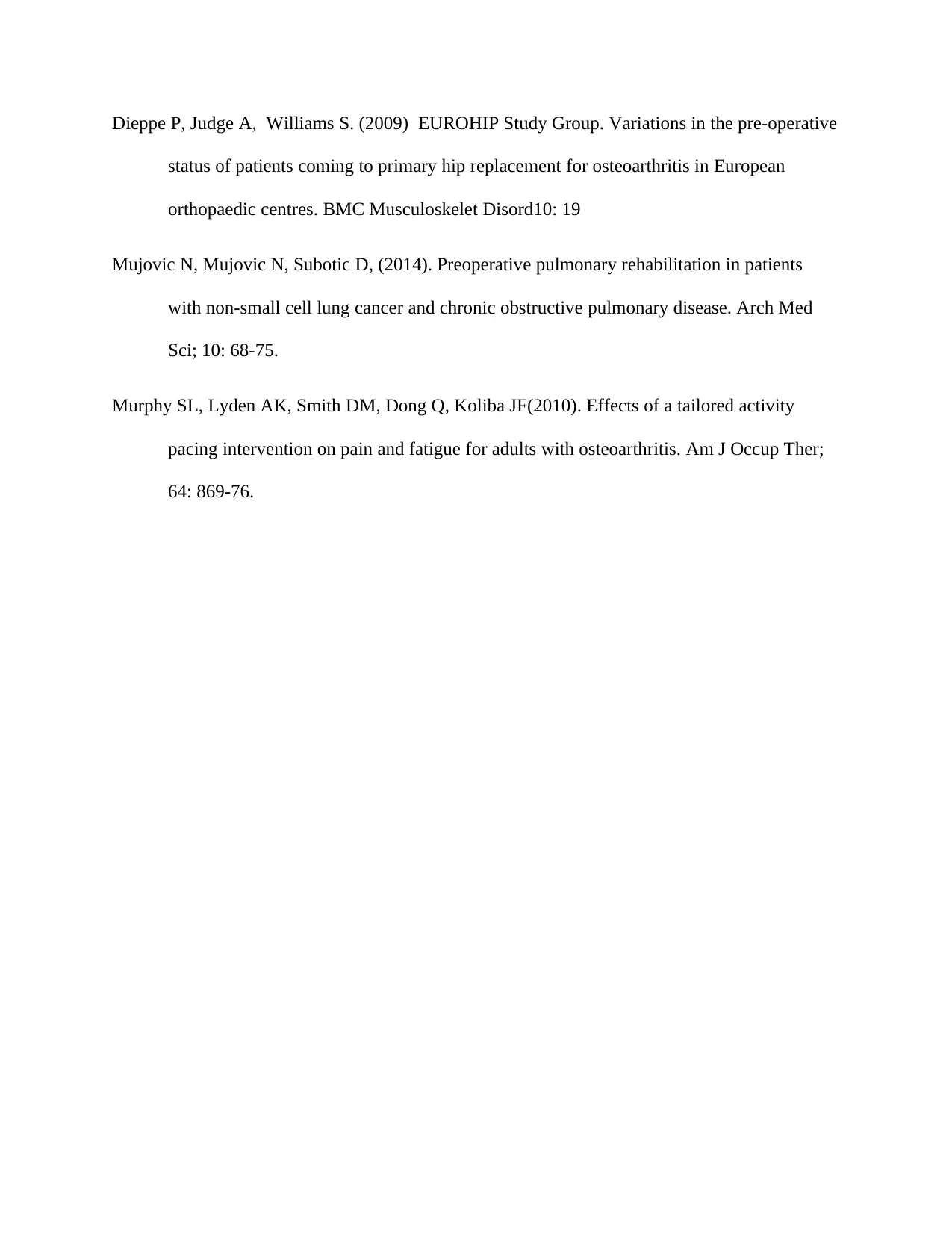
Dieppe P, Judge A, Williams S. (2009) EUROHIP Study Group. Variations in the pre-operative
status of patients coming to primary hip replacement for osteoarthritis in European
orthopaedic centres. BMC Musculoskelet Disord10: 19
Mujovic N, Mujovic N, Subotic D, (2014). Preoperative pulmonary rehabilitation in patients
with non-small cell lung cancer and chronic obstructive pulmonary disease. Arch Med
Sci; 10: 68-75.
Murphy SL, Lyden AK, Smith DM, Dong Q, Koliba JF(2010). Effects of a tailored activity
pacing intervention on pain and fatigue for adults with osteoarthritis. Am J Occup Ther;
64: 869-76.
status of patients coming to primary hip replacement for osteoarthritis in European
orthopaedic centres. BMC Musculoskelet Disord10: 19
Mujovic N, Mujovic N, Subotic D, (2014). Preoperative pulmonary rehabilitation in patients
with non-small cell lung cancer and chronic obstructive pulmonary disease. Arch Med
Sci; 10: 68-75.
Murphy SL, Lyden AK, Smith DM, Dong Q, Koliba JF(2010). Effects of a tailored activity
pacing intervention on pain and fatigue for adults with osteoarthritis. Am J Occup Ther;
64: 869-76.
⊘ This is a preview!⊘
Do you want full access?
Subscribe today to unlock all pages.

Trusted by 1+ million students worldwide
1 out of 9
Related Documents
Your All-in-One AI-Powered Toolkit for Academic Success.
+13062052269
info@desklib.com
Available 24*7 on WhatsApp / Email
![[object Object]](/_next/static/media/star-bottom.7253800d.svg)
Unlock your academic potential
Copyright © 2020–2025 A2Z Services. All Rights Reserved. Developed and managed by ZUCOL.





